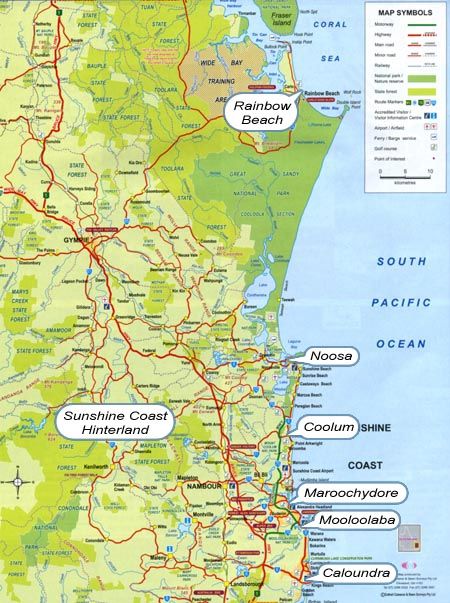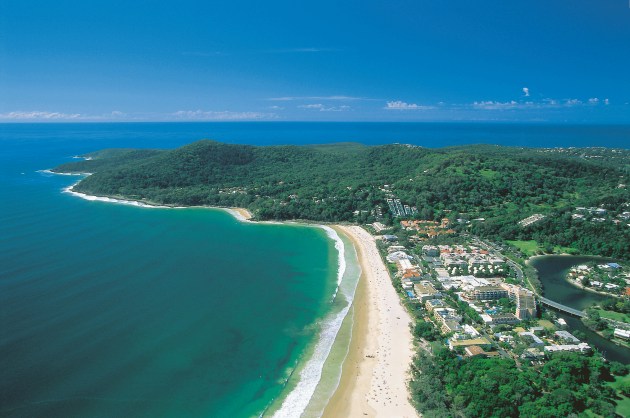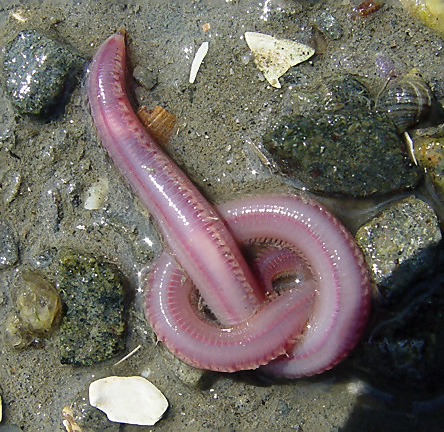 |
| Map of Australia's Sunshine Coast |
The study was conducted south of Noosa, Southern Queensland, on the east coast of Australia. The scientists picked out four sampling plots at each of four beaches; each beach contained two reference and two impact plots evenly divided between the upper and lower shore. Impact plots were those where sand disturbance showed signs of clear human activity, while reference plots were less intensively trafficked, if at all, by beach-goers. Multiple cores were collected from each plot so the researchers could measure species abundance, richness, diversity, and community composition, as well as grain size and moisture content of the sand.
Although the "morphodynamic beach conditions"--in other words, characteristics such as slope and distance from low water mark--were similar between reference and impact treatments, there were clear differences in disturbance level. There were many more footprints in the impact plots along the lower shore, and these were found at a higher density than in reference areas. Human-trafficked areas had coarser sand and approximately half as much moisture; the latter pattern was probably driven by trampling, which "may enhance water loss from the sediment" by breaking the "thin surface crust" of the sand.
 |
| Sunshine Coast near Noosa |
Likewise, abundance of benthic (or bottom-dwelling) organisms was reduced by as much as 72% in the seawards impact plots; declines of individual species were as high as 90%. Impacted species included the amphipod Urohaustorius halei, and bloodworms (Glycera spp.). Density and diversity were also lower (by up to 55% and 68%, respectively) in the seawards plots, and overall spatial variation in community structure was significantly related to the intensity of human habitat use at the lower shore.
Dunes are generally thought to be more sensitive to anthropogenic disturbance, while areas closer to the shore are typically perceived as more robust. In particular, dune flora and macrofauna are known to be at risk from human traffic. However, the researchers did not find any significant differences in microfauna between impact and reference plots along the upper beach; species such as the isopod Pseudolana concinna, the most common upper shore benthic animal, could be found at similar levels in all dune-wards plots. Thus, as far as sand-dwelling invertebrates are concerned, shoreline areas are more dangerous than habitats along the upper beach.
 |
| Bloodworm (Glycera spp.) |
According to the researchers, the most parsimonious explanation for their results is "crushing of organisms" by foot traffic. If so, it would appear that pedestrian activities are in many ways comparable to beach vehicular traffic, in terms of negatively impacting microfauna and disturbing their habitat--a surprising result given that heavier, faster-moving vehicles seem intuitively more dangerous. Unfortunately, the authors list this as only one of several anthropogenic disturbances at beaches; others include removal of "cast and wrack" from the shoreline, installation of infrastructure, and beach grooming, to name a few. Although it seems likely that these various factors work together to harm the ecosystem, it is not yet clear whether their impacts are additive or multiplicative.
In order to minimize the harmful effects of human activities, the researchers suggest three major interventions: limiting the number of beach visitors, using signs and fences to funnel visitors to particular areas, and, where necessary, going one step further and officially zoning the beach into wildlife-only refuges and human-accessible recreational areas. Since the first technique is unlikely to get much support, the authors state that it will be important to focus instead on second two options. Zoning efforts have already seen some success, and can take advantage of visitor interest in particular areas of the beach--for instance, those near facilities, established footpaths, and sites with life guards. Another important step will be preventing the formation of new tracks that take beach-goers too close to sensitive beach wildlife. Hopefully, some combination of these techniques will preserve species assemblages, and also, therefore, the "functional integrity" of beach ecosystems.
---
Schlacher, T.A. and Thompson, L. 2012. Beach recreation impacts benthic invertebrates on ocean-exposed sandy shores. Biological Conservation 147:123-132.
Thanks to the following websites for providing the images used in this post:
http://www.qldtravel.com.au/sunshine-coast/sunshine-coast-map.html
http://www.sydney-australia.biz/queensland/sunshine-coast/
http://zottoli.wordpress.com/saltmarshes/gallery-of-selected-photographs/
No comments:
Post a Comment